spring security 简单使用
本文介绍了如何创建一个基于Spring Security的登录注册示例项目。主要内容包括:1) 创建Maven项目并配置pom.xml依赖,引入Spring Boot、Spring Security、Thymeleaf等核心组件;2) 配置安全过滤器链,设置URL访问权限、表单登录和注销功能;3) 使用InMemoryUserDetailsManager实现内存用户存储,预置测试用户(user/p
·
1、新建maven项目spring-security-demo
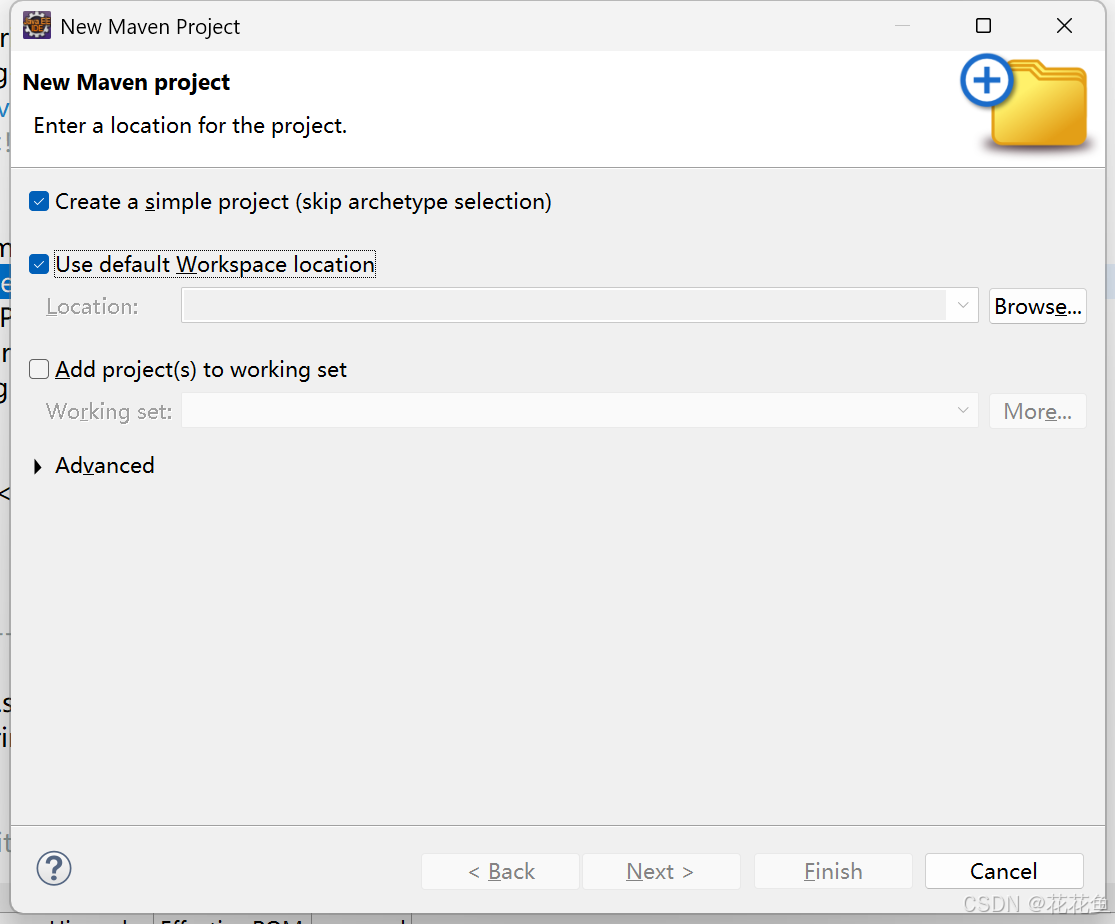
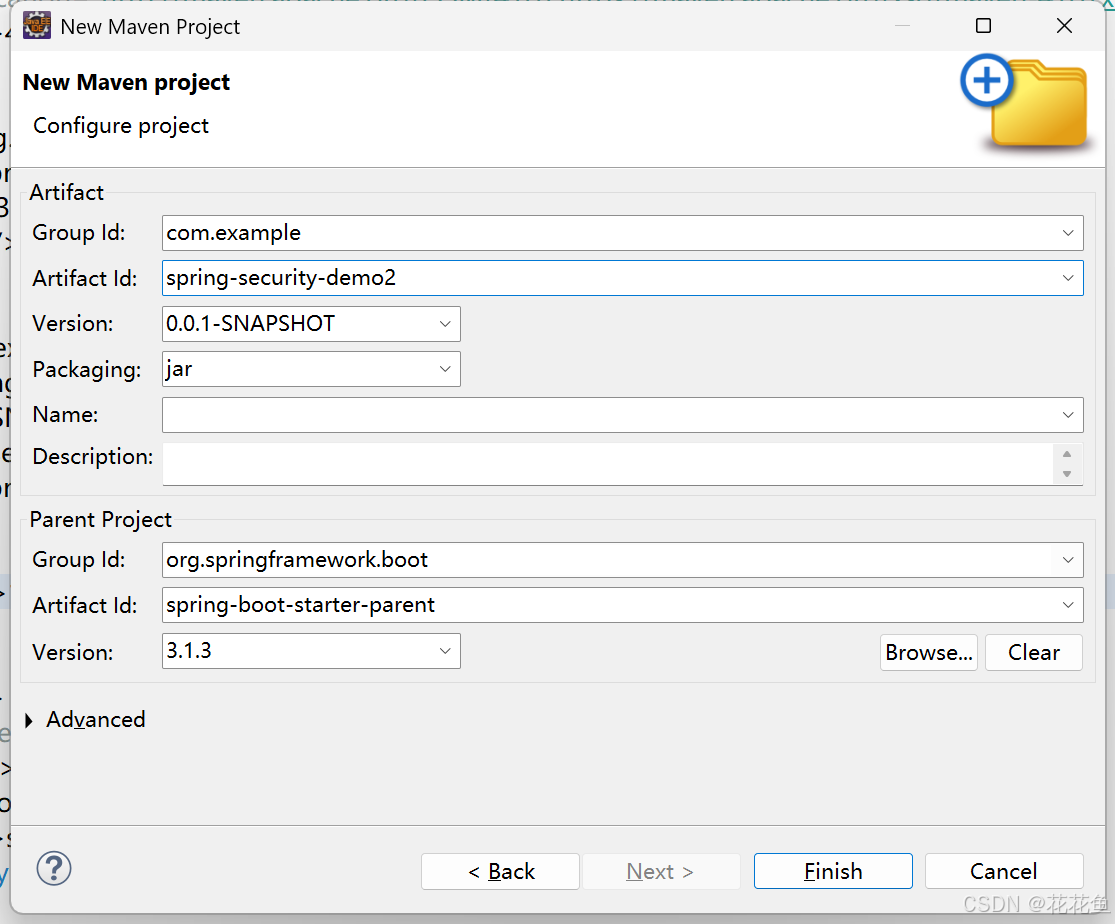
2、编写pom.xml
<?xml version="1.0" encoding="UTF-8"?>
<project xmlns="http://maven.apache.org/POM/4.0.0" xmlns:xsi="http://www.w3.org/2001/XMLSchema-instance"
xsi:schemaLocation="http://maven.apache.org/POM/4.0.0 https://maven.apache.org/xsd/maven-4.0.0.xsd">
<modelVersion>4.0.0</modelVersion>
<parent>
<groupId>org.springframework.boot</groupId>
<artifactId>spring-boot-starter-parent</artifactId>
<version>3.1.3</version>
<relativePath/> <!-- lookup parent from repository -->
</parent>
<groupId>com.example</groupId>
<artifactId>spring-security-demo</artifactId>
<version>0.0.1-SNAPSHOT</version>
<name>spring-security-demo</name>
<description>Spring Security 登录注册示例</description>
<properties>
<java.version>17</java.version>
</properties>
<dependencies>
<!-- Spring Web -->
<dependency>
<groupId>org.springframework.boot</groupId>
<artifactId>spring-boot-starter-web</artifactId>
</dependency>
<!-- Spring Security -->
<dependency>
<groupId>org.springframework.boot</groupId>
<artifactId>spring-boot-starter-security</artifactId>
</dependency>
<!-- Thymeleaf模板引擎 -->
<dependency>
<groupId>org.springframework.boot</groupId>
<artifactId>spring-boot-starter-thymeleaf</artifactId>
</dependency>
<!-- Thymeleaf与Spring Security集成 -->
<dependency>
<groupId>org.thymeleaf.extras</groupId>
<artifactId>thymeleaf-extras-springsecurity6</artifactId>
</dependency>
<!-- 测试依赖 -->
<dependency>
<groupId>org.springframework.boot</groupId>
<artifactId>spring-boot-starter-test</artifactId>
<scope>test</scope>
</dependency>
<dependency>
<groupId>org.springframework.security</groupId>
<artifactId>spring-security-test</artifactId>
<scope>test</scope>
</dependency>
</dependencies>
<build>
<plugins>
<plugin>
<groupId>org.springframework.boot</groupId>
<artifactId>spring-boot-maven-plugin</artifactId>
</plugin>
</plugins>
</build>
</project>
3、编写代码
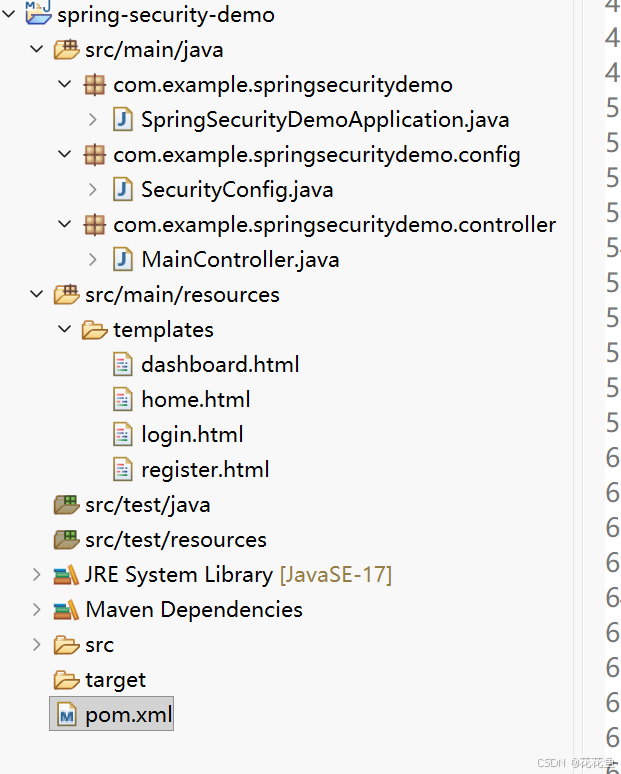
4、运行测试
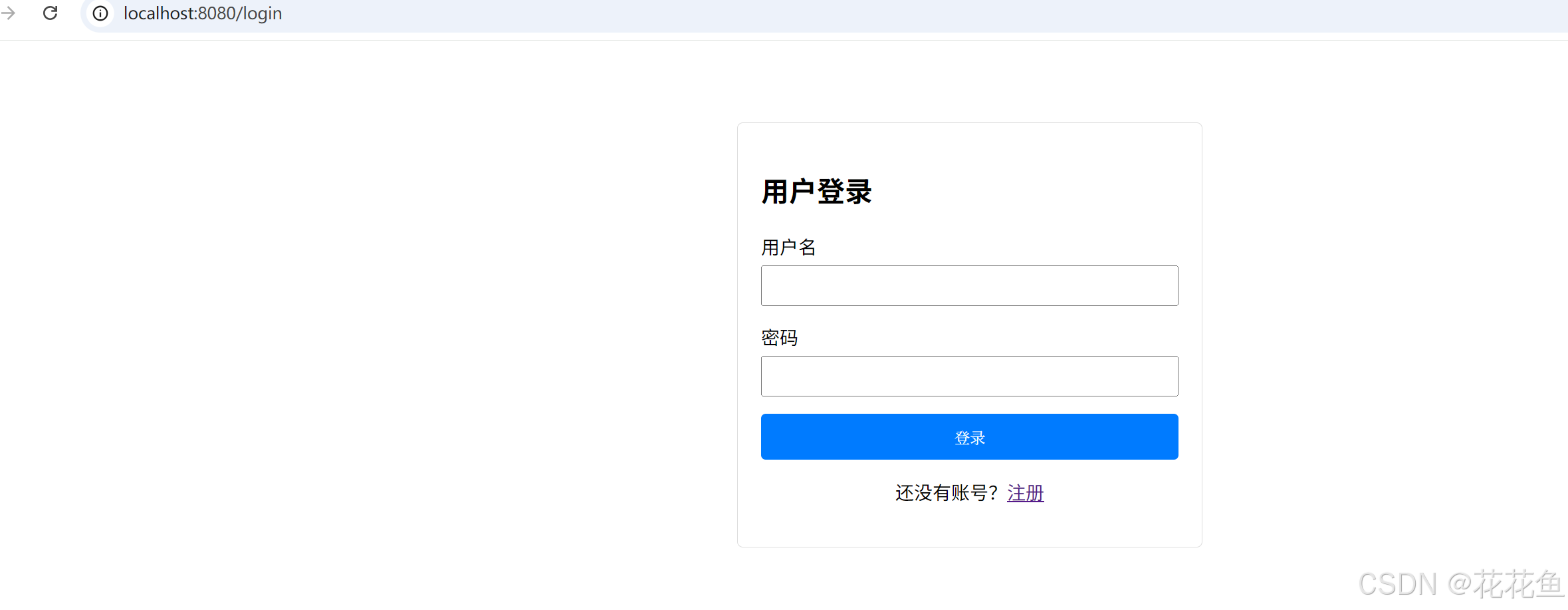
输入账号,密码:user,password登录
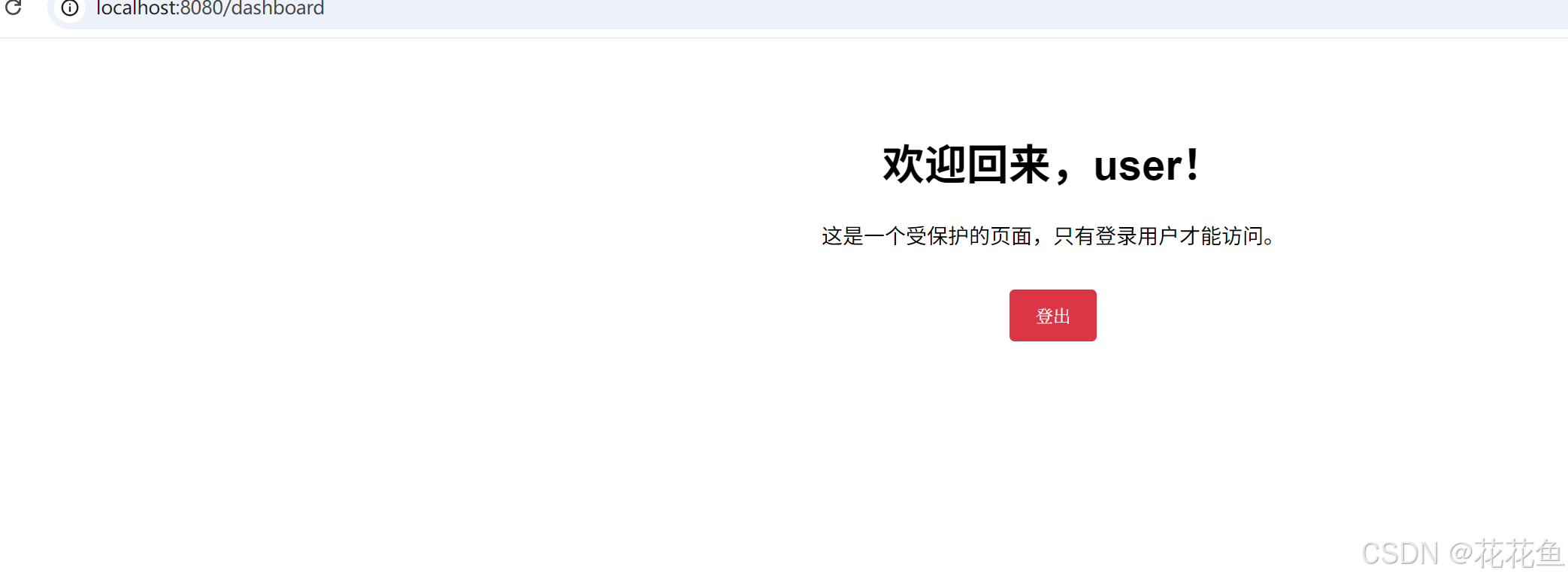
登录成功显示,欢迎,也可以点击【登出】返回到登录。
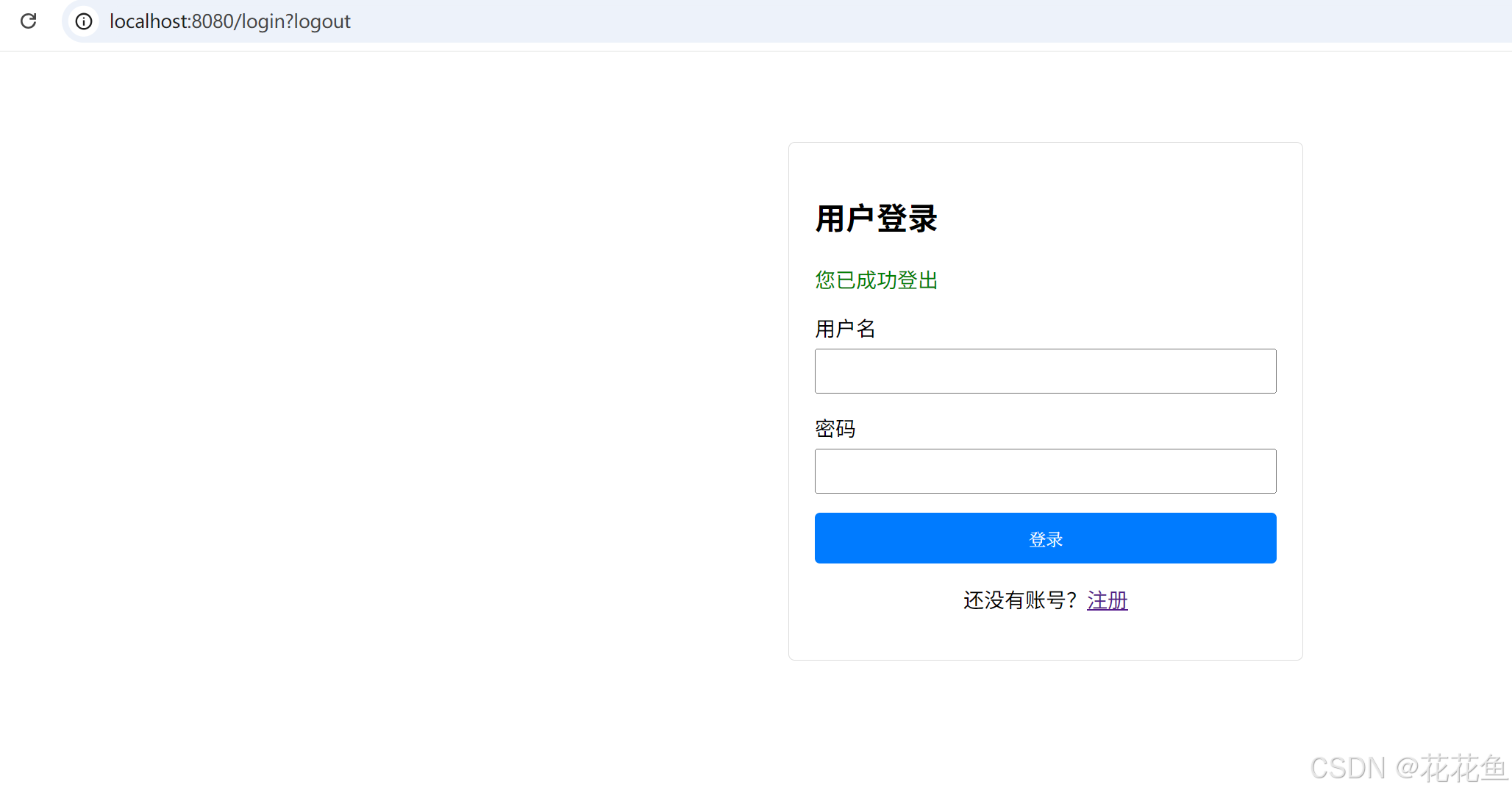
5、代码说明:
@Configuration
@EnableWebSecurity
public class SecurityConfig {
// 密码编码器
@Bean
public PasswordEncoder passwordEncoder() {
return new BCryptPasswordEncoder();
}
// 内存用户存储
@Bean
public UserDetailsService userDetailsService() {
// 创建一个默认用户
UserDetails user = User.builder()
.username("user")
.password(passwordEncoder().encode("password"))
.roles("USER")
.build();
return new InMemoryUserDetailsManager(user);
}
// 安全过滤链配置
@Bean
public SecurityFilterChain filterChain(HttpSecurity http) throws Exception {
http
.authorizeHttpRequests(auth -> auth
.requestMatchers("/", "/home", "/register", "/register-process").permitAll() // 允许匿名访问的路径
.anyRequest().authenticated() // 其他所有路径需要认证
)
.formLogin(form -> form
.loginPage("/login") // 自定义登录页
.defaultSuccessUrl("/dashboard", true) // 登录成功后跳转的页面
.permitAll()
)
.logout(logout -> logout
.logoutRequestMatcher(new AntPathRequestMatcher("/logout"))
.logoutSuccessUrl("/login?logout") // 登出成功后跳转的页面
.permitAll()
);
return http.build();
}
}
这里是5.7+的版本,用的SecurityFilterChain ,不是基于WebSecurityConfigurerAdapter的configure,如果是低版本的,可以使用以下的配制:
package com.example.security.config;
import org.springframework.context.annotation.Bean;
import org.springframework.context.annotation.Configuration;
import org.springframework.security.config.annotation.authentication.builders.AuthenticationManagerBuilder;
import org.springframework.security.config.annotation.web.builders.HttpSecurity;
import org.springframework.security.config.annotation.web.configuration.EnableWebSecurity;
import org.springframework.security.config.annotation.web.configuration.WebSecurityConfigurerAdapter;
import org.springframework.security.core.userdetails.User;
import org.springframework.security.core.userdetails.UserDetails;
import org.springframework.security.core.userdetails.UserDetailsService;
import org.springframework.security.crypto.bcrypt.BCryptPasswordEncoder;
import org.springframework.security.crypto.password.PasswordEncoder;
import org.springframework.security.provisioning.InMemoryUserDetailsManager;
@Configuration
@EnableWebSecurity // 启用Web安全配置
public class SecurityConfig extends WebSecurityConfigurerAdapter {
// 密码加密器
@Bean
public PasswordEncoder passwordEncoder() {
return new BCryptPasswordEncoder();
}
// 内存用户存储
@Bean
@Override
public UserDetailsService userDetailsService() {
// 预创建一个测试用户
UserDetails user = User.builder()
.username("user")
.password(passwordEncoder().encode("password"))
.roles("USER")
.build();
return new InMemoryUserDetailsManager(user);
}
// 配置HTTP安全规则
@Override
protected void configure(HttpSecurity http) throws Exception {
http
.authorizeRequests()
.antMatchers("/", "/login", "/register", "/error").permitAll() // 允许匿名访问的路径
.anyRequest().authenticated() // 其他路径需要认证
.and()
.formLogin()
.loginPage("/login") // 自定义登录页
.defaultSuccessUrl("/dashboard", true) // 登录成功后跳转
.permitAll()
.and()
.logout()
.logoutSuccessUrl("/") // 登出成功后跳转
.permitAll();
}
}
6、下载demo
通过网盘分享的文件:spring-security-demo.zip
链接: https://pan.baidu.com/s/1z0HG-FNq8dJlBajsJQhltw 提取码: muw2
7、实现说明
这个示例实现了以下功能:
-
安全配置:
- 使用
SecurityFilterChain替代了过时的WebSecurityConfigurerAdapter - 配置了 URL 访问权限:首页、登录页和注册页允许匿名访问,其他页面需要认证
- 启用了表单登录和注销功能
- 使用
-
用户存储:
- 使用
InMemoryUserDetailsManager实现内存存储用户 - 预创建了一个测试用户(用户名:user,密码:password)
- 使用 BCrypt 加密算法对密码进行加密存储
- 使用
-
注册功能:
- 提供注册页面,用户可以输入用户名和密码
- 检查用户名是否已存在
- 将新注册用户添加到内存存储中
-
页面模板:
- 首页:提供登录和注册入口
- 登录页:处理用户登录,显示登录状态消息
- 注册页:处理用户注册,检查用户名唯一性
- 用户中心:受保护页面,只有登录用户可访问
使用方法
- 访问首页(
/),可以看到登录和注册链接 - 可以直接使用测试用户登录(user/password)
- 也可以注册新用户,然后使用新用户登录
- 登录后可以访问受保护的
/dashboard页面 - 点击 "登出" 按钮可以退出登录
这个示例使用了 Thymeleaf 作为模板引擎,你需要在项目中添加相应的依赖才能正常运行。内存模式适合演示和测试,实际生产环境中通常会使用数据库存储用户信息。
更多推荐
 已为社区贡献28条内容
已为社区贡献28条内容

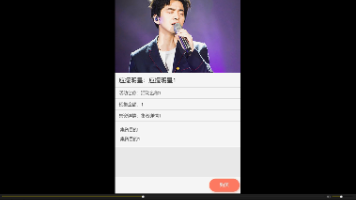





所有评论(0)